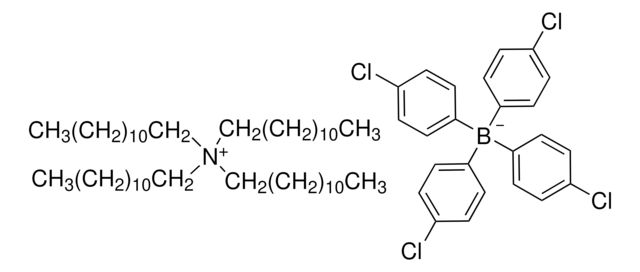60591
Potassium tetrakis(4-chlorophenyl)borate
Selectophore™, ≥98.0%
Sinonimo/i:
Tetrakis(4-chlorophenyl)boron potassium
About This Item
Prodotti consigliati
Grado
for ion-selective electrodes
Livello qualitativo
Nome Commerciale
Selectophore™
Saggio
≥98.0% (AT)
≥98.0%
Stato
solid
Stringa SMILE
[K+].Clc1ccc(cc1)[B-](c2ccc(Cl)cc2)(c3ccc(Cl)cc3)c4ccc(Cl)cc4
InChI
1S/C24H16BCl4.K/c26-21-9-1-17(2-10-21)25(18-3-11-22(27)12-4-18,19-5-13-23(28)14-6-19)20-7-15-24(29)16-8-20;/h1-16H;/q-1;+1
SAGICZRAKJSWLD-UHFFFAOYSA-N
Cerchi prodotti simili? Visita Guida al confronto tra prodotti
Descrizione generale
Applicazioni
Confezionamento
Note legali
Avvertenze
Danger
Indicazioni di pericolo
Consigli di prudenza
Classi di pericolo
Acute Tox. 3 Oral
Codice della classe di stoccaggio
6.1C - Combustible acute toxic Cat.3 / toxic compounds or compounds which causing chronic effects
Classe di pericolosità dell'acqua (WGK)
WGK 3
Punto d’infiammabilità (°F)
Not applicable
Punto d’infiammabilità (°C)
Not applicable
Dispositivi di protezione individuale
dust mask type N95 (US), Eyeshields, Gloves
Scegli una delle versioni più recenti:
Possiedi già questo prodotto?
I documenti relativi ai prodotti acquistati recentemente sono disponibili nell’Archivio dei documenti.
I clienti hanno visto anche
Il team dei nostri ricercatori vanta grande esperienza in tutte le aree della ricerca quali Life Science, scienza dei materiali, sintesi chimica, cromatografia, discipline analitiche, ecc..
Contatta l'Assistenza Tecnica.
![Sodium tetrakis[3,5-bis(trifluoromethyl)phenyl]borate Selectophore™](/deepweb/assets/sigmaaldrich/product/structures/251/439/7a621e74-bfd1-4a43-833c-09adfcc1e0b3/640/7a621e74-bfd1-4a43-833c-09adfcc1e0b3.png)


![Potassium tetrakis[3,5-bis(trifluoromethyl)phenyl]borate Selectophore™](/deepweb/assets/sigmaaldrich/product/structures/631/130/b5486f44-2e69-40d0-902f-dd71894a6add/640/b5486f44-2e69-40d0-902f-dd71894a6add.png)







